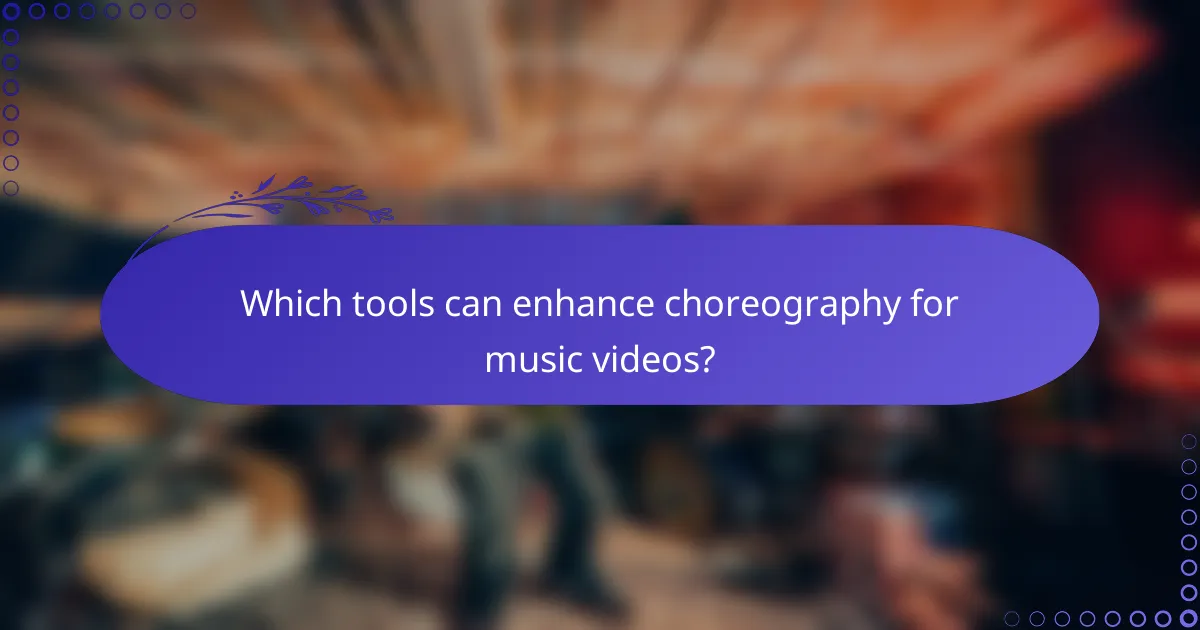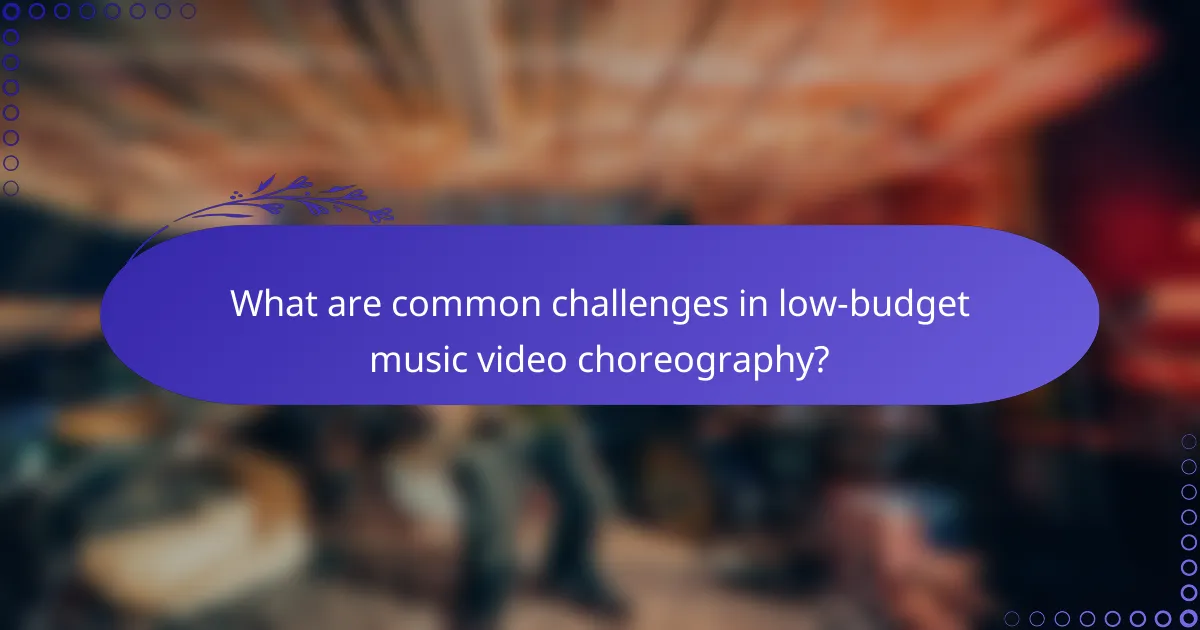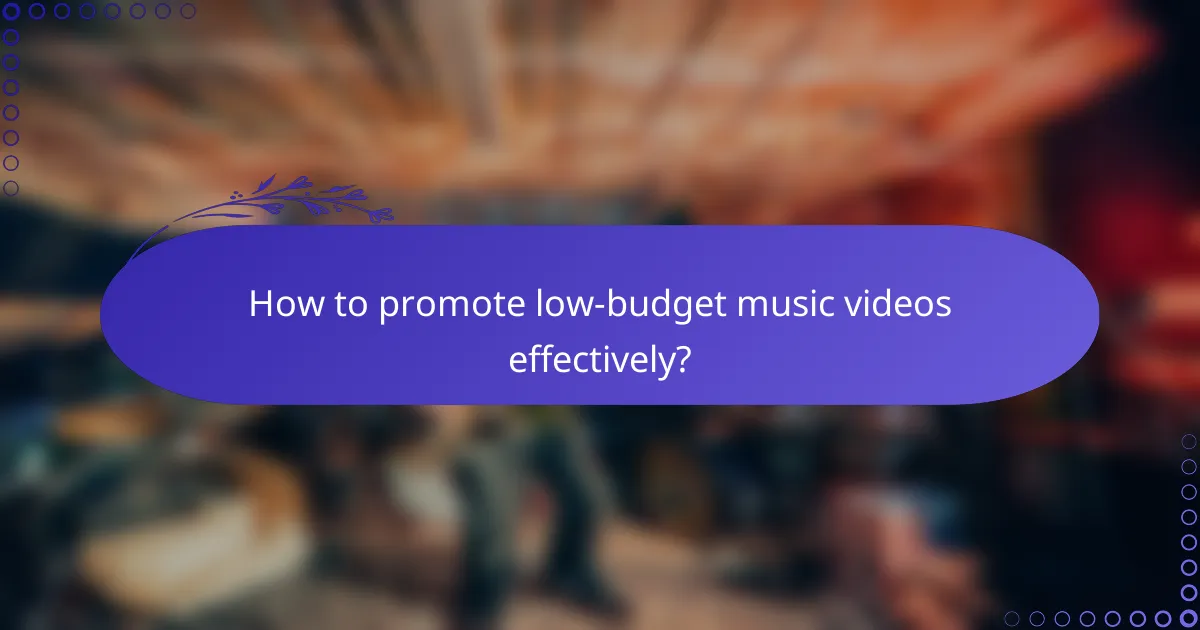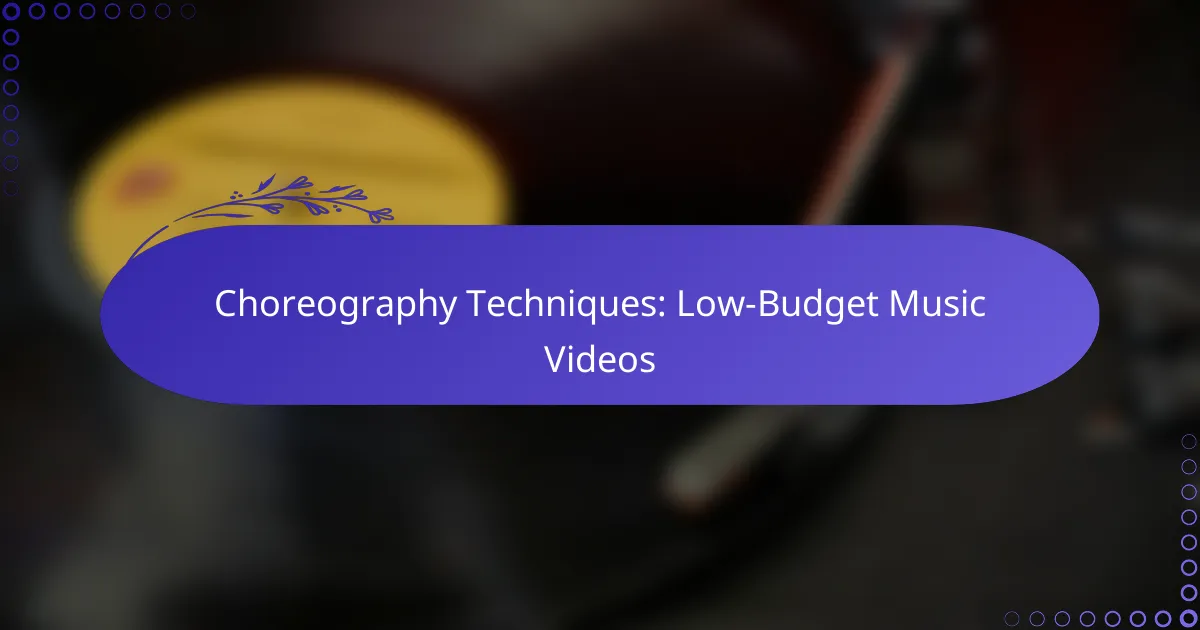Creating low-budget music videos that feature engaging choreography is entirely achievable with the right techniques and resources. By leveraging smartphone technology, natural lighting, and free editing tools, you can produce visually appealing content that captivates audiences without breaking the bank. Focusing on creative movements and storytelling will enhance your production, allowing you to maximize impact while minimizing costs.

How to create low-budget music videos using choreography techniques?
Creating low-budget music videos with choreography techniques involves using accessible tools and resources to achieve professional-looking results. By focusing on smartphone filming, natural lighting, free editing software, local talent, and simple dance routines, you can produce engaging content without significant financial investment.
Utilize smartphone cameras for filming
Smartphone cameras have advanced significantly, making them a viable option for filming music videos. Most modern smartphones can shoot in high definition, allowing for clear and vibrant visuals. Consider using a tripod or stabilizer to minimize shaky footage, enhancing the overall quality.
Experiment with different angles and perspectives to add visual interest. Utilize features like slow motion or time-lapse to create dynamic shots that can elevate your choreography without additional costs.
Incorporate natural lighting
Natural lighting can dramatically improve the look of your music video without any expense. Filming during the golden hour—shortly after sunrise or before sunset—provides soft, flattering light that enhances colors and reduces harsh shadows. Aim to shoot outdoors or near large windows for the best results.
Be mindful of the weather and time of day, as these factors can affect lighting conditions. Avoid shooting in direct sunlight, which can create unflattering contrasts; instead, look for shaded areas or overcast days for even lighting.
Leverage free editing software
There are numerous free editing software options available that can help you polish your music video. Programs like DaVinci Resolve, HitFilm Express, and Lightworks offer robust features for video editing, color correction, and sound mixing without the need for a subscription or purchase.
Familiarize yourself with the software’s capabilities through online tutorials. Focus on basic editing techniques such as cutting, transitions, and adding effects to enhance your choreography and overall video flow.
Engage local dancers
Collaborating with local dancers can bring energy and creativity to your music video while keeping costs low. Reach out to dance schools, community centers, or social media groups to find talented individuals who may be interested in participating for exposure or experience.
Consider hosting auditions or workshops to select dancers who align with your vision. Building a rapport with your dancers can lead to more dynamic performances and a collaborative atmosphere during filming.
Use simple choreography
Simple choreography can be just as impactful as complex routines, especially when executed well. Focus on creating memorable movements that are easy to learn and perform, allowing dancers to showcase their skills without overwhelming them.
Incorporate repetitive patterns or signature moves that can be easily remembered. This approach not only makes rehearsals more efficient but also ensures that the choreography complements the music and enhances the overall visual appeal of the video.

What are effective choreography techniques for low-budget productions?
Effective choreography techniques for low-budget productions focus on maximizing visual impact while minimizing costs. By utilizing creative movements, formations, and storytelling, you can create engaging music videos without the need for extensive resources.
Focus on group formations
Group formations are essential in low-budget choreography as they create a dynamic visual experience. Consider arranging dancers in various shapes such as lines, circles, or triangles to enhance the overall aesthetic. This approach not only fills the frame but also allows for easy transitions between scenes.
Experiment with different formations to find what best suits the music and theme. For instance, a tight formation can convey unity, while a scattered arrangement might express chaos. Keep in mind that changing formations during the performance can maintain viewer interest without requiring elaborate set designs.
Incorporate storytelling through movement
Storytelling through movement adds depth to your choreography, making it more relatable and engaging. Use gestures, facial expressions, and body language to convey emotions and narratives that resonate with the audience. This technique can transform a simple dance into a compelling visual story.
To effectively incorporate storytelling, define a clear theme or message for your video. For example, if the song is about love, use movements that reflect connection and intimacy. Consider using props or simple costumes to enhance the narrative without incurring high costs.
Use repetition for memorability
Repetition is a powerful tool in choreography, especially for low-budget productions. By repeating key movements or formations, you create memorable moments that stick with the audience. This technique can also help dancers learn and retain choreography more easily.
When utilizing repetition, aim for a balance between familiarity and variety. For instance, you might repeat a signature dance move during the chorus while introducing slight variations in the verses. This approach keeps the performance engaging while reinforcing the central theme of the music.

Which tools can enhance choreography for music videos?
Several tools can significantly enhance choreography for music videos, focusing on both planning and editing. Utilizing specialized apps and video editing software can streamline the creative process and improve the final product.
Choreography apps like Dance Designer
Choreography apps such as Dance Designer allow creators to visualize and plan dance sequences effectively. These tools often feature a user-friendly interface that lets users map out movements, assign formations, and even collaborate with others in real-time.
When using these apps, consider the specific features that suit your project needs, such as customizable avatars or the ability to integrate music tracks. This can help you create a more cohesive and engaging choreography that aligns with your music video’s theme.
Video editing tools like DaVinci Resolve
Video editing tools like DaVinci Resolve provide robust features for enhancing choreography in music videos. With capabilities for color grading, audio synchronization, and visual effects, these tools can elevate the overall production quality.
For low-budget projects, DaVinci Resolve offers a free version with many professional-grade features. Focus on learning key functionalities like timeline editing and keyframing to effectively highlight choreography. Avoid overusing effects, as this can distract from the dance itself.

What are common challenges in low-budget music video choreography?
Common challenges in low-budget music video choreography include limited rehearsal time, resource constraints, and finding suitable locations. These factors can significantly impact the quality and execution of the choreography, requiring creative solutions to achieve the desired outcome.
Limited rehearsal time
Limited rehearsal time is a frequent issue in low-budget music videos, often leaving choreographers with only a few hours to prepare. This constraint can hinder the dancers’ ability to fully grasp complex routines, leading to less polished performances.
To maximize efficiency, prioritize key sections of the choreography that are most visually impactful. Consider breaking down the routine into smaller, manageable parts to facilitate quicker learning and retention.
Resource constraints
Resource constraints encompass a lack of budget for hiring professional dancers, equipment, or studio space. This limitation can lead to the use of amateur performers or improvised settings, which may not always align with the artistic vision.
Utilize available resources creatively, such as collaborating with local dance schools or community groups. This approach can provide talented dancers while keeping costs low. Additionally, consider using minimal props or costumes that can enhance the visual appeal without straining the budget.
Finding suitable locations
Finding suitable locations for filming can be challenging, especially when budget restrictions limit options. Ideal settings may require permits or fees, which are often not feasible for low-budget productions.
Explore public spaces, such as parks or urban areas, that do not require extensive permits. Always check local regulations regarding filming in these areas to avoid potential fines. Alternatively, consider using a home or studio setting that can be easily transformed to fit the video’s theme.

How to promote low-budget music videos effectively?
To promote low-budget music videos effectively, focus on leveraging digital platforms and community engagement. Utilizing social media and collaborating with influencers can significantly enhance visibility without substantial financial investment.
Utilize social media platforms
Social media platforms are essential for promoting low-budget music videos due to their vast reach and cost-effectiveness. Create engaging content tailored to each platform, such as short clips or behind-the-scenes footage, to attract viewers.
Consider using platforms like Instagram, TikTok, and YouTube, which are popular for music-related content. Posting regularly and interacting with followers can help build a loyal audience and encourage shares, increasing your video’s exposure.
Collaborate with influencers
Collaborating with influencers can amplify the reach of your low-budget music videos. Identify influencers whose audience aligns with your target demographic, and propose partnerships that benefit both parties, such as shoutouts or joint content creation.
When approaching influencers, be clear about your budget constraints and offer creative ways to collaborate, like featuring them in your video or having them promote it on their channels. This can lead to increased visibility and engagement without high costs.
